I would not walk 500 miles because when I wake up, I can just roll out of bed and “virtual reality” myself into the theatre.
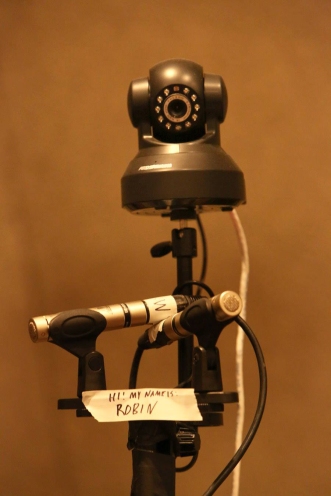
This is my face, in case it wasn’t obvious.
There are a few answers:
- I deeply enjoy introducing Junior Theatre‘s youth to the practical and philosophical world of sound reinforcement and helping to tell a story, but now I live elsewhere.
- In regard to this post, JT’s sound system would be in shambles if I didn’t stick “around” to curate it. Their shows deserve to reach their audiences.
- In 2012, I was given a $26,250 grant to build said sound system, and it breaks my heart each time I return after someone else gets their hands on it, and find it in utter disarray.
- It seemed like a good idea at the time.
- Can it be done? Challenge Accepted!
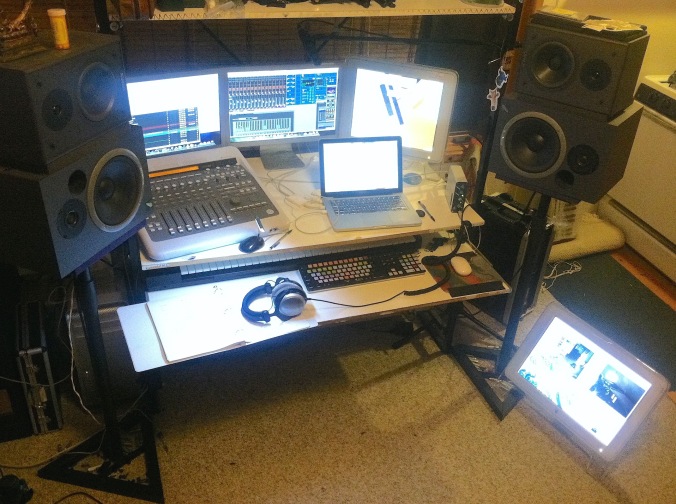
What the “cockpit” looked like for my inaugural remote sound design show, The Little Mermaid
What is actually happening? And why am I talking about it like it’s monumental?
After implementing an assortment of technologies to enable me to accomplish what’s listed below, I am able to sound design shows at San Diego Junior Theatre from my cabin in the woods of Santa Cruz – in real-time. As far as my internet searching revealed, nobody else has done something like this.

If you’re not aware what a theatrical sound designer does, check out this blog post. (For the record, I’m filling both artistic and technical roles.) In my particular circumstances with Junior Theatre, here’s what I’m responsible for accomplishing:
- Teach students to operate the entire sound system for the production.
- Engineer and arrange the the sound system to enable it, and the student board operators, to effectively and appropriately support the show.
- Create/acquire and implement any music or sound effects needed for the show
- Do all the hundreds of unseen tasks it takes to accomplish everything above
In order to perform these functions, there are a few prerequisite capabilities:
- Communicate effectively with the student board operators
- Observe exactly what board ops are doing (so one can guide it)
- Adjust mixer settings
- Program sound effects playback
- Diagnose microphone and other audio problems
- Hear
- See

Not the best quality of optics, but it gets the job done for now.
I can watch exactly what the board ops are doing on the mixer, hear almost as though I’m right there in the theatre, and offer appropriate suggestions. I can instruct them how to repair, adjust, and do pretty much anything that needs to happen physically (like hand out microphones, replace elements, vacuum the sound booth, get me a latte, reprogram frequencies, plug in floor and orchestra mics, and whatever else pops up.) I interact with the director and production staff almost as naturally as being there – shouting to the back of the theatre at me totally works as it does in real life. I observe the show from multiple vantage points to be sure it’s working properly, and fix what isn’t.
There are definitely drawbacks to not physically being there, but there are also some upsides that I didn’t anticipate when I started this off. I’ll just list the upsides because this is a self-serving post anyway:
- I can observe the mixer and board op. levels, the sound computer and what cues are playing, the sound booth and the stage simultaneously, without even needing to move my head. Normally I have to run around the theatre.
- I can change mixer settings and listen to the elements I’m adjusting, without having to run back to the mixer and shove the board op. out of the way.
- I can create SFX on the fly with my full audio workstation, instead of running over to my laptop, grossly handicapped by limited resources.
- I can throw sound effects on the computer, last minute (oops) via direct file sharing; no USB stick or DropBox necessary. I can program without running over and getting in the way.
- It prevents me from any hands-on micro-management, allowing the board ops to learn quicker, better, and more thoroughly, instead of me running over and “showing” how to do it myself.
- There is very little running around.
Maybe a moment to explain how this came together in the first place?
First – the $26k grant:
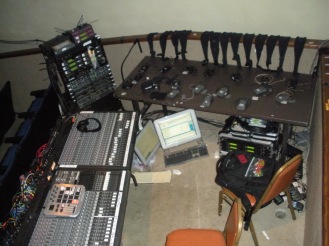
 Casa Del Prado sound booth, Beauty and the Beast 2011, vs Honk! 2012
Casa Del Prado sound booth, Beauty and the Beast 2011, vs Honk! 2012
It’s transformation Tuesday! This city-owned theatre is used by 3 different youth groups, and each were (and still are… but that’s another stupid story) using their own sound systems for every single production, meaning about 12 load-ins and strikes between all our productions, every year. JT secured a grant to install a base sound system that would provide for anyone using the theatre, and also bring JT into the 21st century of audio reinforcement. This whole system design and install deserves its own post, featuring the amazing woodworking skills of my dad. For now I’ll just say that this remote sound design idea had been cooking in my head already, and I incorporated the future potential to support this idea into the new system.
Next – an obsession with capturing sound realistically:
Ever heard of the Mid/Side technique? It’s how radio is encoded to provide two-channel sound over airwaves that still sounds fine when one channel disappears. It’s also a recording technique that allows for stereo width adjustment in post-production. A couple years before doing this install, I had entered a 1950’s era of interest in capturing a live space or instrument as it would sound if you were there in the room. I thought Mid/Side was the holy grail for this, only to discover I was wrong upon finding ambisonics, and then discovering I was still wrong when I much later tried the ORTF binaural technique as a last-ditch effort in perceiving the theatre accurately. Basically, it emulates how our ears capture sound, so when one listens through headphones the brain can perform its natural psycho-acoustic interpolation, proving the listener with 360° sound.

Then – I was accepted to a 4-year university in another city:
I had spent 6 years designing about 35 shows at JT, loading in and striking each one by myself. They were all great experiments in acquiring different tools and skills to get the each show done best, but I had an ongoing daydream about a permanently installed system. This grant was that dream come true, and by then I had worked out exactly what the theatre needed. Problem is that the money came in 6 months after I had moved away. My three-week winter break was spent installing the new system (and designing the 3-show repertory production). Every. Last. Minute. If only I could somehow design the shows and use my new system while I was off at school…
After that – A few more things fell into place:
The theatre is located in historic Balboa Park where new things are highly regulated. DSL was the only internet service to the park. Then, a miracle; fiber-optic internet service was installed which had the bandwidth necessary to support multiple streams. I discovered SoundJack, a free program allowing users to steam low-latency audio to each other, up to 8 channels uncompressed. I figured out how to use VNC screen sharing which allows me to control two computers at the theatre, the sound effects computer, and my “hidden” streaming computer which manages SoundJack and lets me control the mixer. I also discovered IP security cameras, controllable/viewable through an internet browser. Now, there were no more technological barriers to achieving remote sound design, so I bought two IP cameras, a Mac Mini for streaming, microphones and a speaker for ORTF and booth talkback. Then I bought 1000′ of Cat-6 ethernet cable and installed it between the office router, sound booth, computers, and cameras (and the costume loft, which had been quoted at costing $10k+ for an internet connection). And we were up and running! Sort of.
It took a lot of testing and problem solving to get to the point where everything worked dependably enough to attempt designing a show. Not only did I spend about $1,200 on equipment and resources to make this work, but for the first couple shows I also had to hire a local assistant to do the physical work. Since then, I’ve built up a small legion of students who are proficient enough to relieve me of hiring someone. I’ve also refined the process so that there’s very little they need to do in the first place to load-in. With the money and time I’ve invested in making this possible, each additional show I sound design now makes my average $/hr go up. For the first show, I netted about -$800. By the third show, I had finally recouped my investment, and was up to about 200 volunteer hours. 11 shows in and I’m earning close to minimum wage. Yaaaayyyyyy
Here are some photos of the booth from last show that I designed mostly remotely. Not the best photos, but it gives a feel for the environment the students are working in.
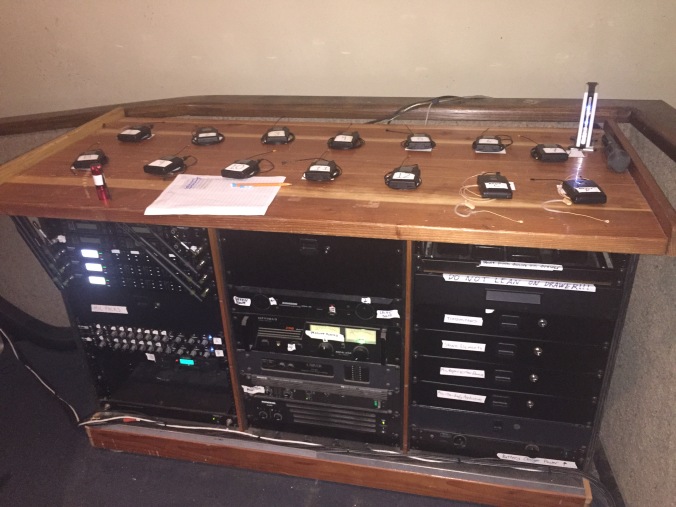

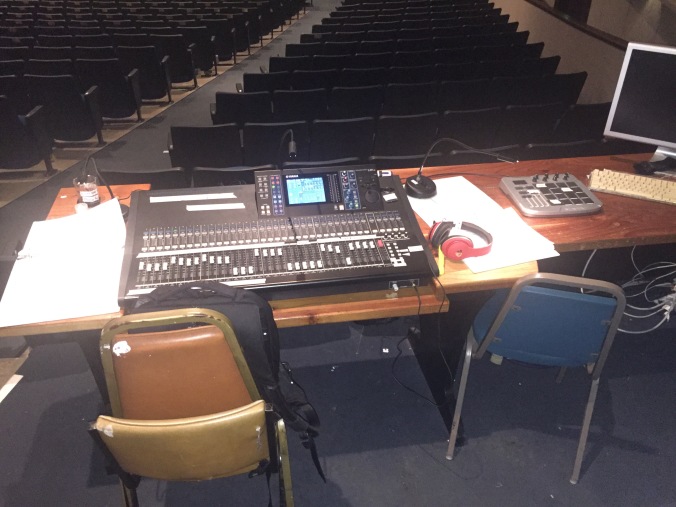

“There’s very little running around” 🙂
LikeLike
I’m glad you enjoyed that! In fact, I wish that there were more running around. It’s difficult to be confined to a chair for so many hours.
LikeLike
great blog, Robin!!
LikeLike
Dankeschön!
LikeLike
Pingback: I got a Billie award in Sound Design! | A Sound Engineer's Weblog
This is a great post thankss
LikeLiked by 1 person
Thanks for reading!
LikeLike